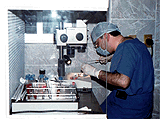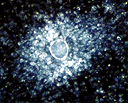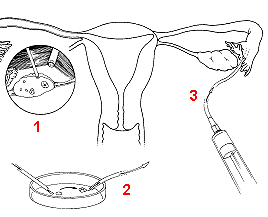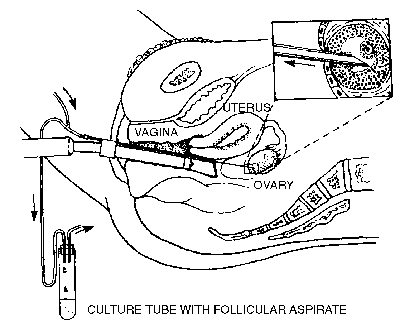GIFT AND IVF
Versión en español
Introduction | GIFT | IVF
GIFT (Gamete Intrafallopian Transfer) and IVF (In-vitro Fertilization), are complex reproductive techniques since both require an invasive procedure to remove the eggs from the ovary. The egg harvest can be performed in the physician's office. However, because of safety reasons, it is recommended to be practiced in the surgery room.
These techniques imply further manipulation of the sperm and eggs, and requires a special Gamete Laboratory with all the facilities to offer to gametes and pre-embryos similar conditions to those present in the female uterus and the Fallopian tubes.

The Gamete Laboratory is our facilities is fully equipped for these procedures according to international standards and following the legal recommendations and rules established for these methods.
GIFT and IVF require the commitment and compromise of the medical staff and the couple to achieve a successful treatment.
[ Page top | Our services | Home ]

The GIFT consists of 4 basic steps:
- Ovulation enhancement.
To increase the number of mature eggs for the procedure, hormones, called menotropins, are used to induce the development of ovarian follicles. During this controlled ovarian hyperstimulation, the monitoring of the follicles is required through a daily ultrasound and the serum levels of estradiol are also determined.
- Egg harvest.
The eggs are obtained by two different manners: the first is vaginal ultrasound-guided aspiration with intravenous analgesia. In this method, the surgeon guides a needle through the vagina into the follicles (1) removing the eggs by suction.
The other method is by laparoscopy, with general anesthesia. The surgeon guides the needle through the abdominal wall into the ovarian follicle looking through the laparoscope.
- Identification of the eggs.
The follicular fluid (with the eggs) is transferred immediately to the Gamete Laboratory to be classified according to its maturity. The amount and quality of the harvested eggs are basic factors for a successful procedure. The selected eggs are mixed with the sperm (of a donor if required) previously prepared (2), and loaded into a catheter which returns to the operating room.

Human oocyte surrounded
by granulosa cells
- Gamete transfer.
The surgeon introduces the gamete cells, up to 3 eggs and 150,000 sperms, into one Fallopian tube (3). If the harvest was done by laparoscopy, the catheter passes trough the abdominal wall. If done by vaginal aspiration, the Fallopian tubes are catheterized is through the uterus with hysteroscopy or ultrasonografic control.

If tubes are damaged (one or both) GIFT must be canceled and instead IVF should be attempted.
When the procedure is finished, the patient remains a few hours at the hospital and is discharged on the same day.
This method allows a success rate between 25-30% per cycle.
[ Page top | Our services | Home ]

The IVF consists of 4 basic stages:
- Ovulation enhancement.
To increase the number of mature eggs for the procedure, drugs called menotropins (hormones that stimulate the ovary) are used to induce the development of ovarian follicles. During this controlled ovarian hyperstimulation is necessary to monitor the follicles with a daily ultrasound and measure the serum levels of estradiol.
- Egg harvest.
The eggs are obtained by two different manners: the first is vaginal ultrasound-guided aspiration with intravenous analgesia. In this method, the surgeon guides a needle through the vagina into the follicles removing the eggs by suction (aspiration). The other method is by laparoscopy with general anesthesia. In this technique, the specialist guides the needle through the abdominal wall into the ovarian follicle looking through the laparoscope. The follicular fluid (with the eggs) is transferred immediately to the Gamete Laboratory to be classified according with its maturity. The woman spends few hours at the hospital and goes back home the same day to continue with her normal activities.

- Insemination and embryo culture.
The amount and quality of the harvested eggs are basic factors for the procedure success. Eggs are prepared in special dishes with culture medium and, when ready, they are inseminated with the sperm previously washed to select exclusively normal and motile cells.
Each egg is inseminated approximately two to 10 hours after the follicular aspiration with 100,000 motile cells and incubated in an oxygen environment and controlled temperature, resembling, as possible the female conditions. About 12 hours later, the biologist searches for signs of fertilization since not all the eggs fertilize. Twelve hours later pre-embryos are re-observed before the transfer.
- Embryo transfer.
Pre-embryos in a two- to- four cells stage are ready to be transferred into the female uterus. Normally this is done 48 to 72 hours after the follicular aspiration. The transfer is made near the Gamete Laboratory to avoid environmental changes that could affect the pre-embryos. The woman lies on the bed and the physician exposes the cervix with a vaginal speculum; no anesthesia is used but, if required, mild sedative or local anesthesia is utilized. In the lab, three or four pre-embryos are drawn in a catheter, and very gently the tip is guided through the cervix and the fluid with the pre-embryos is dispensed into the uterus.
The patient remains in the hospital on bed about two hours after the transfer and is discharged on the same day. It is suggested for the patient to remain at bed for one additional day. Often there are more than four pre-embryos which can be cryopreserved (frozen) and thawed at later date to be transferred in the same couple in another cycle.
The success of these procedures depends on four mainstones:
- Proper selection of the patients, recommending to each couple the procedure with the highest probability of success accordingly with their medical history.
- Compliance of the couple to strictly follow the medical instructions.
- Controlled ovarian hyperstimulation according to current protocols, thus increasing follicular development and maintaining the adequate quality in harvested eggs.
- The Gamete Laboratory staff must be experienced in these procedures to provide the highest technical, ethical and professional standards.
Our group keeps a permanent program of good clinical and laboratory practices and its rate of success is comparative to those obtained in other parts of the world. For example, approximately a 15 to 20 percent rate of success per treatment cycle has been obtained with the IVF procedure.
[ Page top | Our services | Home ]


INSTITUTO DE ESTERILIDAD Y SALUD REPRODUCTIVA, S.C.
Baja California, 181
Col. Roma Sur
Ciudad de México, CP 06760
Tel: (52 55) 55 84 88 41 55 64 39 20 y 7094 75 85
WhatsApp 55 1952 4369
E-mail: info@saludreproductiva.mx

LICENCIA SANITARIA No. 06 T 09 006 0095
RESPONSABLE SANITARIO : Dr. Paolo Marco Ronaldo Mario Di Castro Stringher UNAM
Cédula Profesional 588982

Copyright © 2017, Instituto de Esterilidad y Salud Reproductiva, S.C.
All rights reserved.


![]()


![]()

![]()
![]()
![]()
![]()